Family sawmill going strong at 70
Last updated 2/14/2017 at Noon
For The Record
Jerry Rogers recalls his family moving to Orange in 1965 for what looked to be a short stay.
“Daddy came here to log Sun Oil Company timber back in the woods. He said: ‘In five more years, we’ll have all the timber cut and we’ll have to move.’
“He was off about 50 years.”
The Rogers Lumber Company that Jerry’s dad, William Dayton “W.D.” Rogers, began in 1947 in Arkansas, is celebrating its 70th year in operation and 52rd in Orange.
Three generations of the Rogers family oversee the operation of the family sawmill located along Interstate 10, just west of U.S. 62.
Most weekdays, a steady stream of trucks, each hauling up to 40 tons of freshly cut East Texas pine, delivers logs, which are unloaded and stacked around the 2-acre lot.
A full crew off 11 men operate the machines that can turn a 33-foot log into a 20-foot 12x12 or 6x6 post in 2 minutes, with a support crew just as large.
“We cut about 25,000 board feet a day,” says Jeff Rogers, the executive vice president of the company and the fourth generation to work in the family business.
That’s the equal of about six log trucks of lumber. It would be enough to build two homes – if the wood was used that way.
“We produce dimensional timber, the big, heavy timbers for building use,” Jeff Rogers said.
Rogers Lumber Company sells most of its lumber to processing companies around Houston.
“They pressure treat those [timbers] and sell them into industrial construction. They use them in building bridges out of wood, bulkheads and beach pilings on shorelines, any kind of heavy wooden structure,” Jeff Rogers said.
“Big boards are our niche. We do produce lumber off the sides of those timbers, 1x4s and such. But we don’t sell them to the building trades.
“We don’t have dry kilns, planers and dryers to do finished lumber.”
But Rogers Lumber Company has provided food and board to four generations of family since the 1960s.
In fact, the company office is in a building that once was a family homestead.
Jeff, 34, and a 2000 graduate of Community Christian School in Orange, manages the business end of the mill, which includes keeping the logs coming in and the timbers going out.
His wife Melinda, sister Briana and mother Mary Jane run the office.
Vince, Jeff’s father and Jerry’s son, is the company president. He keeps the machines running.
And Jerry, the 75-year-old past president, works on the many circular saw blades needed to keep the operation going, grinding and sharpening the teeth.
W.D. Rogers started the business in 1947, operating a portable sawmill with his brother. The two split the business and decendents of W.D. Rogers’ brother operate a sawmill in Camden, Ark.
“My father [Jerry] and grandfather [W.D.] came to Texas in the 1960s as loggers with a portable sawmill for the promise of cheap and abundant timber because of the pine beetle,” Vince said in a history of the business published last fall by the Texas Forestry Association.
That brought them to Sour Lake in 1963 and then to Orange, where they first leased the land for the portable sawmill. They soon built a wood structure around it.
That structure burned in a 1968. The Rogers family bought the land and rebuilt the mill from the ground up, this time with a steel structure. It withstood two hurricanes in the past dozen years.
The last decade has seen computers make an appearance in the business, if only for bookkeeping purposes.
“We don’t do any kind of internet sales,” Jeff says. “Our web page is just for informational purposes, so people can find out about us.
“We were handwriting invoices and payroll up until 2009 or so.”
Also in the last decade, Rogers Lumber Company has gotten out of the logging business.
“Until 2008, we had a logging company and cut our own timber,” Jeff Rogers said. “In the late 90s, we started to supplement by buying from outside sources. That made our logging operation unnecessary, so we shut it down in 2008.
“Now our typical wood basket [purchasing range] is 60 miles, from Jasper south. We buy it from loggers.”
But the sawmill operates pretty much the same way it always has.
“Markets come and go. We sell to different customers now. We buy from different logging companies now. Rolling stocks – trucks and stuff – have to be upgraded,” Jeff Rogers said.
“We’ve had an idea here and there on ways to be more efficient. But mostly it’s the way we’ve done it since the 70s.
“I’m mostly just carrying on what the generations before me have done.”
To watch a load of logs go through the mill is a treat.
First, a log loader, a huge John Deere tractor with a claw arm attachment, brings five or six logs at a time to a rack of rollers and conveyors.
One by one, the logs go through a cutoff saw that trims the wood to specific pre-programmed lengths. Then the logs are rolled through a “debarker.”
The “head rig” pushes and pulls the log back and forth through the main saw, a blade 5- to 3.5-feet tall that shaves off the outside of the log to arrive at the desired size, 12x12 or 6x6.
The final touch is a trip through the edger and trimmer.
The big timbers are then pushed to the side and machine stacked, then carried by forklifts to await shipping.
The “sides,” those pieces of wood cut off the outside of the logs, are directed through a planer that converts those to the smaller boards like 1x4s.
Pieces smaller than that are fed into chippers and the chips are sold to a paper mill. Sawdust is pulled by vacuums throughout the process; it is sold for fuel.
Even the pine bark from the debarker is headed to re-use, as mulch from neighboring blueberry farms.
“We try not to waste anything,” Jeff Rogers said. “We sell all of it.”
As the only independent saw mill southeast of Hardin County, the Rogers Lumber Company sees a big future for sawmills.
“We hope so,” Jeff Rogers said. “For a while, everything was trending toward steel, but now there’s an effort to bring the forest sector back to construction.”
He says there are more trees, not less, pointing to a U.S. Forest Service report that between 2007 and 2012, forest areas in the country increased at a rate of 5,800 football fields per day.
“We get more logs today that when Daddy said we’d have to move out of here,” Jerry Rogers, the patriarch of the family, said.
“It’s wonderful how God replenishes us.”



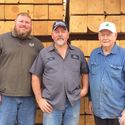
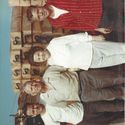
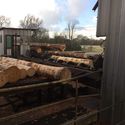
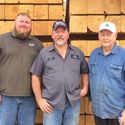
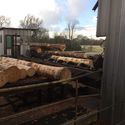













Reader Comments(0)